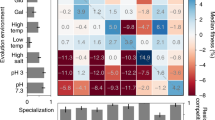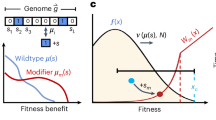Abstract
Successive adaptive radiations have played a pivotal role in the evolution of biological diversity1,2,3. The effects of adaptive radiation are often seen4,5,6, but the underlying causes are difficult to disentangle and remain unclear7,8,9. Here we examine directly therole of ecological opportunity and competition in driving genetic diversification. We use the common aerobic bacterium Pseudomonas fluorescens10, which evolves rapidly under novel environmental conditions to generate a large repertoire of mutants11,12,13. When provided with ecological opportunity (afforded by spatial structure), identical populations diversify morphologically, but when ecological opportunity is restricted there is no such divergence. In spatially structured environments, the evolution of variant morphs follows a predictable sequence and we show that competition among the newly evolved niche-specialists maintains this variation. These results demonstrate that the elementary processes of mutation and selection alone are suifficient to promote rapid proliferation of new designs and support the theory that trade-offs in competitive ability drive adaptive radiation14,15.
This is a preview of subscription content, access via your institution
Access options
Subscribe to this journal
Receive 51 print issues and online access
$199.00 per year
only $3.90 per issue
Buy this article
- Purchase on SpringerLink
- Instant access to full article PDF
Prices may be subject to local taxes which are calculated during checkout




Similar content being viewed by others
References
Gould, S. J. Wonderful Life: The Burgess Shale and the Nature of History (Penguin, London, 1989).
Hedges, S. B., Parker, P. H., Sibley, C. G. & Kumar, S. Continental breakup and the ordinal diversification of birds and mammals. Nature 381, 226–229 (1996).
Benton, M. J. Diversification and extinction in the history of life. Science 268, 52–58 (1996).
Otte, D. & Endler, J. A. (eds) Speciation and its Consequences (Sinauer, Sunderland, 1989).
Dobzhansky, T. Species of Drosophila. Science 177, 664–669 (1972).
Klein, D. et al. Extensive MHC variability in cichlid fishes of Lake Malawi. Nature 364, 330–334 (1993).
Schluter, D. Experimental evidence that competition promotes divergence in adaptive radiation. Science 266, 798–801 (1994).
Grant, P. R. Ecology and Evolution of Darwin's Finches (Princeton Univ. Press, NJ, 1986).
Lenski, R. E. & Travisano, M. Dynamics of adaptation and diversification: a 10,000 generation experiment with bacterial populations. Proc. Natl Acad. Sci. USA 91, 6808–6814 (1994).
Rainey, P. B. & Bailey, M. J. Physical and genetic map of the Pseudomonas fluorescens SBW25 chromosome. Mol. Microbiol. 19, 521–533 (1996).
Shaprio, J. A. in The Bacteria; The Biology of Pseudomonas (ed. Sokatch, J. R.) 27–69 (Academic, London, 1986).
Rainey, P. B., Moxon, E. R. & Thompson, I. P. Intraclonal polymorphism in bacteria. Adv. Microb. Ecol. 13, 263–300 (1993).
Moxon, E. R., Rainey, P. B., Nowak, M. & Lenski, R. E. Adaptive evolution of highly mutable loci in pathogenic bacteria. Curr. Biol. 4, 24–33 (1994).
Taper, M. T. & Case, T. J. in Oxford Surveys in Evolutionary Biology, Vol. 8 (eds Futuyma, D. J. & Antonovics, J.) 63–109 (Oxford Univ. Press, Oxford, 1994).
Connell, J. H. The influence of interspecific competition and other factors on the distribution of the barnacle Chthamalus stellatus. Ecology 42, 710–723 (1961).
Charlesworth, B., Lande, R. & Slatkin, M. Aneo-Darwinian commentary on macroevolution. Evolution 46, 16–30 (1982).
Travisano, M., Mongold, J. A., Bennett, A. F. & Lenski, R. E. Experimental tests of the roles of adaptation, chance, and history in evolution. Science 267, 87–90 (1995).
Elena, M. S. F., Cooper, V. S. & Lenski, R. E. Punctuated evolution caused by selection of rare beneficial mutations. Science 272, 1802–1804 (1996).
Rosenzweig, M. L. Species Diversity in Space and Time (Cambridge Univ. Press, Cambridge, 1995).
Conway Morris, S. & Whittington, H. B. The animals of the Burgess shale. Sci. Am. 240, 122–133 (1979).
Hopf, F. A., Valone, T. J. & Brown, J. H. Competition theory and the structure of ecological communities. Evol. Ecol. 7, 142–154 (1993).
Bell, G. & Reboud, X. Experimental evolution in Chlamydomonas. II. Genetic variation in strongly contrasted environments. Heredity 78, 498–506 (1997).
Lenski, R. E., Rose, M. R., Simpson, S. C. & Tadler, S. C. Long-term experimental evolution in Escherichia coli. I. Adaptation and divergence during 2,000 generations. Am. Nat. 138, 1315–1341 (1991).
Atwood, K. C., Schneider, L. K. & Ryan, F. J. Periodic selection in Escherichia coli. Proc. Natl Acad. Sci. USA 37, 146–155 (1951).
Abrams, P. A. Alternative models of character displacement and niche shift. 2. Displacement when there is competition for a single resource. Am. Nat. 130, 271–282 (1987).
Haldane, J. B. S. The Causes of Evolution (Longmans & Green, London, 1932).
Hedrick, P. W. Genetic polymorphism in heterogeneous environments: a decade later. Annu. Rev. Ecol. Syst. 17, 535–566 (1986).
Rosenzweig, R. F., Sharp, R. R., Treves, D. S. & Adams, J. Microbial evolution in a simple unstructured environment — genetic differentiation in Escherichia coli. Genetics 137, 903–917 (1994).
Turner, P. E., Souza, V. & Lenski, R. E. Tests of ecological mechanisms promoting the stable coexistence of two bacterial genotypes. Ecology 77, 2119–2129 (1996).
Korona, R., Nakatsu, C. H., Forney, L. J. & Lenski, R. E. Evidence for mutliple adaptive peaks from populations of bacteria evolving in a structured habitat. Proc. Natl Acad. Sci. USA 91, 9037–9041 (1994).
Acknowledgements
We thank K. McCallum for technical assistance; J. Baker for photography; D. Ebert, S. Kahn, B. Haubold, and E. R. Moxon for discussion; and R. E. Lenski, P. Sniegowski and I. Moore for comments ont he manuscript. This work was supported in part by grants from the B.B.S.R.C. and BTP Plc.
Author information
Authors and Affiliations
Corresponding author
Rights and permissions
About this article
Cite this article
Rainey, P., Travisano, M. Adaptive radiation in a heterogeneous environment. Nature 394, 69–72 (1998). https://doi.org/10.1038/27900
Received:
Accepted:
Published:
Issue Date:
DOI: https://doi.org/10.1038/27900
This article is cited by
-
Cyclic-di-GMP promotes bacteria–host association
Nature Microbiology (2023)
-
Bacterial c-di-GMP has a key role in establishing host–microbe symbiosis
Nature Microbiology (2023)
-
Mutualism-enhancing mutations dominate early adaptation in a two-species microbial community
Nature Ecology & Evolution (2023)
-
Identifying Targets of Selection in Laboratory Evolution Experiments
Journal of Molecular Evolution (2023)
-
Geographic distribution pattern and ecological niche differentiation of endangered Opisthopappus in Taihang Mountains
Brazilian Journal of Botany (2023)




